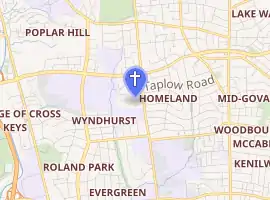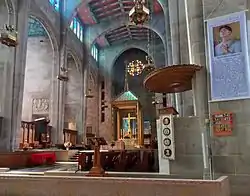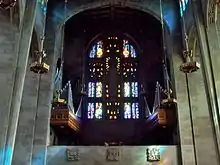Cathedral of Mary Our Queen, Baltimore
The Cathedral of Mary Our Queen is a cathedral of the Roman Catholic Church located at 5200 North Charles Street, in northern Baltimore, Maryland, USA. The structure, remarkable in size, was completed in 1959.
| Cathedral of Mary Our Queen | |
|---|---|
 View of the front of the Cathedral of Mary Our Queen | |

| |
| 39°21′31″N 76°37′34″W | |
| Location | 5200 North Charles Street Baltimore, Maryland |
| Country | |
| Denomination | Roman Catholic Church |
| Website | www |
| History | |
| Status | Cathedral |
| Dedication | Blessed Virgin Mary |
| Consecrated | October 13, 1959 |
| Architecture | |
| Functional status | Active |
| Architectural type | Cathedral |
| Style | English Gothic/Neo-Gothic |
| Groundbreaking | October 1954 |
| Completed | 1959 |
| Specifications | |
| Capacity | 2,000 sitting |
| Length | 373 feet (114 m) |
| Width | 132 feet (40 m) |
| Number of spires | 2 |
| Spire height | 163 feet (50 m) |
| Materials | brick, limestone |
| Administration | |
| Archdiocese | Baltimore |
| Clergy | |
| Archbishop | The Most Reverend William E. Lori |
| Rector | Reverend Monsignor Richard W. Woy |
| Assistant priest(s) | Reverend Father Kevin Ewing |
| Deacon(s) | Mr. William Senft, Mr. Frederick Bauerschmidt |
Cathedral

The cathedral is the seat of the Archbishop of Baltimore, succeeding the Basilica of the National Shrine of the Assumption of the Blessed Virgin Mary, on Cathedral Street at Mulberry Street, in downtown Baltimore. Because Baltimore is the Premier See of the United States and the downtown basilica was the nation's first Roman Catholic cathedral, it now serves as Co-cathedral of the archdiocese.
On March 20, 2012 Bishop William Lori of Bridgeport, Connecticut became 16th Archbishop of Baltimore, succeeding Archbishop (later Cardinal) Edwin F. O'Brien, who was named Grand Master of the Equestrian Order of the Holy Sepulchre of Jerusalem by Pope Benedict XVI. Monsignor Richard W. Woy is Rector. The cathedral is located in the Homeland area of northern Baltimore City and near Loyola University Maryland and St. Mary's Seminary and University, the first Catholic seminary in the United States. It was constructed using funds bequeathed by an Irish Baltimore merchant, Thomas J O'Neill. "It is the only cathedral in the 2,000 year history of the Church that was donated by a single individual" [1]
"As befits any cathedral, this building has its legends, the following of which is Gospel truth. A midwestern stained-glass make was commissioned to provide windows honoring the fine arts for the stairway leading to the choir-loft. He elected to sketch an anonymous church to represent architecture, but was advised by the architect to depict some Baltimore church of his own choosing. To the Catholic Encyclopedia went the artist, where he found pictures of several local churches under the article on the Archdiocese of Baltimore. He picked the church which most appealed to him, sketched it, made the window, and sent the glass to the cathedral, where it was properly installed. Only later was it discovered that the artist had chosen Corpus Christi, the parish church of the donor, Thomas J O'Neill. Mr. O'Neill attended Mass in Corpus Christi , itself a gift church, on the day of his death in April, 1918."[2]
Groundbreaking

In October 1954, ground was broken for the new cathedral. On the morning of October 13, 1959, a few days past the fifth anniversary of the groundbreaking, Bishop Jerome Sebastian consecrated the cathedral. The design is modified Gothic with Art Deco accents, constructed of brick faced with limestone, and uses a classical east-facing cruciform floor plan. The cathedral measures 373 feet (114 m) long, 132 feet (40 m) wide and 163 feet (50 m) to the top of the two spires and can accommodate 2,000 people.[3]
The Cathedral features and extensive sculptural program executed by Joseph Coletti.[4]
Crypt
The crypt under the main floor of the cathedral is reserved for the remains of archbishops and auxiliary bishops of Baltimore. The list of bishops buried in the crypt:
- Bishop Jerome Aloysius Daugherty Sebastian, d. 1960
- Archbishop Francis Patrick Keough, d. 1961
- Cardinal Lawrence Shehan, d. 1984
- Bishop Thomas Austin Murphy, d. 1991
- Bishop Philip Francis Murphy, d. 1999[5]
- Archbishop William Donald Borders, d. 2010
- Bishop William Clifford Newman, d. 2017[6]
Additional
A cellphone antenna is concealed within one tower, generating revenue for the congregation and diocese.[7]
Pope John Paul II visited both the Cathedral of Mary Our Queen and the Basilica, as Pope in 1995 and in 1976 as Cardinal Karol Wojtyla. A plaque outside the Blessed Sacrament Chapel in the north transept commemorates the 1995 visit.
Organs

The cathedral has two organs. The original organs were Opus 9200 of the M. P. Moller Company of Hagerstown, Maryland. After 46 years of use and some considerable damage due to water and smoke the congregation decided to restore the cathedral organs in 2005. It chose Schantz Organ Co. of Ohio to restore and replace many parts of the original instruments. The restoration began with the removal of the Great Gallery organ and, after it was reinstalled and operable, work began on the Chancel organ.
In addition to new pipe work, voice work, new wind chests, Schantz built two new identical four-manual consoles: one for the Gallery and one for the Chancel allowing the organist to control both organs from either location. The chancel console can be moved around the sanctuary to suit various needs. In the original Moller installation, the Great Gallery organ console had four-manuals and could control over both the Gallery and Sanctuary organs. The Sanctuary organ console was two manuals, had complete control over the Sanctuary organ and the Gallery organ through "blind" controls. The Sanctuary console was replaced in 1974 due to a fire in the console which caused smoke damage to both organs' pipework. After the renovations, the Great Gallery organ holds 100 ranks and the Sanctuary organ holds 27.[8]
The first solo concert performance on the restored organ occurred July 5, 2007 by Cherry Rhodes as part of the closing ceremonies of the American Guild of Organists regional convention held in Baltimore.[9]
See also
| Wikimedia Commons has media related to Mary Our Queen Cathedral, Baltimore. |
References
- Defend Life, April 11, 2017
- Catholic Review article by Fr. Thomas Whelan, dated September 28, 1962
- "Cathedral of Mary Our Queen". Archdiocese of Baltimore. Archived from the original on 2013-12-03. Retrieved 2013-11-15.
- Coletti, Joseph, The Sculpture of Joseph Coletti, introduction by Alan Priest, The Macmillian Company, New York, 1968 plates 101-113
- "The Cathedral Crypt". Cathedral of Mary Our Queen. Archived from the original on 2013-09-30. Retrieved 2013-11-15.
- "In Memoriam: Archbishop William D. Borders". Cathedral of Mary Our Queen. Archived from the original on 2014-10-25. Retrieved 2015-12-30.
- Margulius, David L. (May 1, 2003). "Cellphones Ring Out With the Help of a Steeple". The New York Times.
- "Cathedral Music". Cathedral of Mary Our Queen. Archived from the original on 2013-12-02. Retrieved 2013-11-15.
- "Our Convention — They Say It Best" (PDF). The Pipe & Pedal. American Guild of Organists Baltimore Chapter. August 2007. Archived from the original (PDF) on 2016-03-04. Retrieved 2013-11-15.
